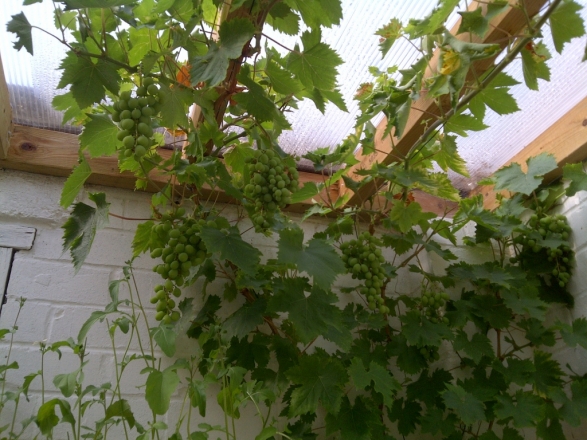On this page you will find tips on how to make wine using fruits and vegetables as well as viewing wine recipes.
In February 2008, whilst living in Grimsby, I was lucky to be allocated an allotment with 2 apple trees, 2 gooseberry bushes and a series of well trained blackberry bushes. The 2 gooseberry bushes looked uncared for, but they produced a large quantity of berries as did the blackberries later in the season. Many years before, I had made my own wine from concentrates and having shown an interest in winemaking, my father gave me his old wine kit and books. With such a bumper crop of fruit I invested in a freezer and put thoughts of homemade wine to one side.
In January 2009 I dug out my Dad’s wine book and set about making my first batch of wine. Because of the large quantity of fruit I made 4 gallons of blackberry followed by 4 gallons of gooseberry. In the early summer of 2009 I made 4 gallons of elderflower ‘champagne’ having seen an inspiring episode of River Cottage. I had no idea how either batch would turn out, but as it happened I first sampled my gooseberry wine and my sparkling elderflower champagne whilst watching the sun go down on my allotment later on that summer. I would like to think it was the clarity and flavour that affected me, rather than the alcohol content....but sat there on that summers evening I knew I had discovered a whole new way of living. The gooseberry wine tasted just as good as a supermarket Chenin Blanc and so I was inspired to carry on with my wine making.
Moving to Priory Cottage made things easier as there was a purpose built airing cupboard with a hot water tank. One difficulty I had at my home in Grimsby was consistency of temperature during the fermentation period (20-23 degrees). That problem is now in the past and I have great consistency with my wine making. The consistency is also to do with the fact that I stick with a basic formula and method for each 4 gallon batch. I always add around 5kg of sugar but in stages. At the start I add 3kg then after fermentation slows I add a further 1kg. Thereafter I add amounts of 500g until I get the right balance, preferring a dry/medium wine with most fruits/vegetables.
Having moved to Priory Cottage in May 2010, I visited the Old Town Festival during July of that year. In the exhibition tent I saw a section for home made wine and immediately thought about entering next years competition. My main aim was to see how my wine compared with other exhibitors, as well as giving me some incentive to produce a higher quality wine. I was therefore overjoyed in July the following year when my gooseberry wine gained first prize in the novice section! I also gained a 3rd place for my parsnip and 3rd place for my elderflower. On my birthday in 2012 I entered 3 wines gaining two 1st prizes and a 2nd place. Buoyed my previous earlier success, in 2013 I entered a total of 7 wines gaining 2 x 1st, 3 x 2nd and 2 x 3rd. Suffice to say I will continue to enter my wines in future years! The number of entries in each category is sometimes only 3 and so this can diminish the value of the prize awarded. In some respects it is a bit of fun, but there is a part of me that hopes other people may be inspired to enter in future years, thus increasing the level of competition.
At Priory Cottage we have established a favourite portfolio of strawberry, rhubarb, parsnip, Elderflower and Beetroot. This year we will be adding raspberry and elderberry. In 2014 we hope to add Gooseberry once the bushes have established themselves on the allotment. We did experiment with cucumber and also with pea pod. Both had fantastic clarity, but didn’t have a pleasant after taste. But waste not want not. We turned the cucumber to vinegar and blended the pea pod with a sweet blackberry. We also had a nice damson 2 years ago, but the trees have not fruited in the last 2 seasons.
The parsnip and beetroot wines are a ‘no brainer’ as the beets are boiled to extract the flavour. The residual water forms the basis of the wine and the beet is then available to eat. As we do 4 gallon batches the beet is frozen to be used at our convenience.
This year has seen the first crop from our grape vine, though not enough to make any wine, but they tasted lovely and so the future looks promising, especially as we have 2 new vines to plant, courtesy of a gift from my brother Bob.
With such a good crop of beetroot and an abundance of elderflower and elderberry 2013 has seen us start to make 8 gallons at a time, in 2 x 4 gallon fermenters. I hope to report progress on their quality during the maturing process throughout the year.
For each of the wines we make I hope to make available my notes so that any enthusiasts or beginners can compare with their own methods and take any tips to help with their production. These will follow in due course when I have a little more time to update. But for now, here’s hoping the wine becomes good after a vintage 2013. |





